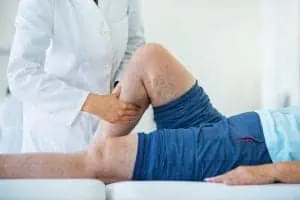
Varicose veins appear as enlarged and twisted, and most commonly show up in the legs and feet because standing and walking increases pressure in the veins of the lower body. They almost always indicate an underlying medical issue and can cause pain. They may indicate a higher risk of circulatory issues that should be evaluated and treated by a vein specialist. Because they require medical intervention, insurance typically covers treatment for varicose veins. Spider veins are a milder type of varicose veins that are smaller, red and blue in color and usually are found on the face and legs.
Causes and Risk Factors
Blood moves toward the heart through valves in the veins. Sitting or standing for long periods can cause blood to pool in the leg veins, enlarging and stretching the veins, weakening vein walls and damaging valves. Several factors may contribute to the development of varicose veins, such as:
- Being older. Age increases wear and tear of valves in veins over time.
- Being female. Women are more likely to develop varicose veins. Hormonal changes during pregnancy or due to birth control pills or hormone replacement therapy may contribute.
- Having a family history of varicose veins.
- Being overweight, which puts added pressure on the veins.
- Standing or sitting for long periods of time.
Complications
Severe varicose veins can produce swelling and result in more serious skin and tissue problems such as ulcers and non-healing sores. Complications of varicose veins can include:
- Ulcers that form on the skin near varicose veins, particularly near the ankles. Look for a discolored spot on the skin that usually begins before an ulcer forms.
- Blood clots or Deep Vein Thrombosis (DVT) in the veins.
- Bleeding in (from) veins close to the skin.
While varicose veins cannot be completely prevented, improving circulation and muscle tone can reduce the risk of developing them. Tips that can help prevent varicose veins include:
- Getting regular exercise.
- Maintaining a healthy weight.
- Eating a high-fiber, low-salt diet.
- Avoiding high heels and tight hosiery.
- Elevating the legs.
- Changing sitting or standing position regularly.
- Wearing compression socks or stockings.
If you are experiencing symptoms or discomfort associated with varicose veins or notice dark colored spots, ulcers or bleeding, it’s important to be evaluated by a vein specialist who can rule out any serious health conditions and treat issues before they become more problematic. The Water’s Edge Vein Center team also can improve the appearance of varicose and spider veins with leading-edge treatments that include microphlebectomy, visual foam sclerotherapy, skin laser treatment, and VeinGogh ohmic thermolysis. Click here to request an appointment today with the Water’s Edge Vein Center team and have your vein health evaluated now: Request an Appointment.





